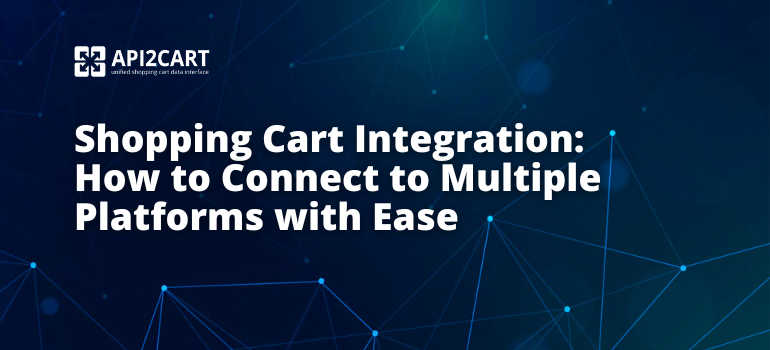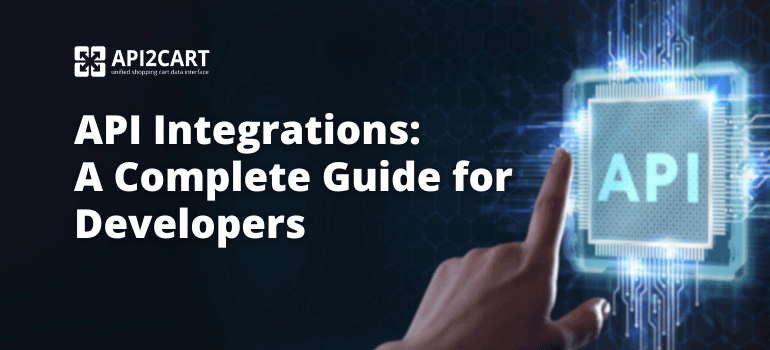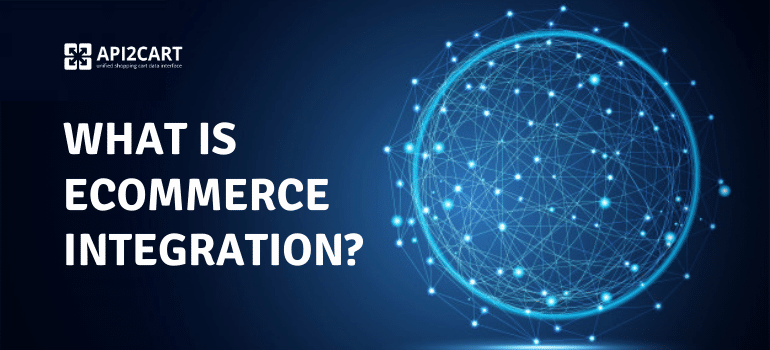
Are you building a software or app that automate different business processes of online store owners? If so, shopping cart integration should be one of your top priorities. Why? Because without these integrations, your software can’t access the core data of your clients’ stores — which means limited functionality and lost opportunities.
Today, there are over 30 million eCommerce stores powered by different shopping cart platforms. That's why developing as much as possible integrations with shopping carts and marketplaces can help your software greatly expand your clients base and market share. The more shopping platforms you integrate with, the higher the chances are to cover the needs of most online merchants.
In this article, you’ll learn why having multiple eCommerce platform integrations is essential for your product’s success — and how you can develop them easier and faster using a ready-made shopping cart API integration solution.
What is the Shopping Cart API?
Shopping cart API (application programming interface) is a kind of access to various types of store information. It includes orders, products, customers, shipments, categories, etc. For every B2B SaaS provider, shopping cart API offers a pool of opportunities.
For example, as an inventory management software vendor, you need to access information related to inventory and synchronize it across all your sales channels from the shopping carts.
When you connect with these platforms, you will be able to retrieve all the required information from e-stores. In this process, the shopping cart API becomes the medium through which the two applications - eCommerce software and shopping cart interact to transfer data. A simple shopping cart API example would be when your software automatically imports orders from Shopify or updates inventory levels on Magento in real time.
What is Shopping Cart Integration?
Shopping cart integration means the process of developing the connection between different software or apps and shopping platforms. The list of shopping platforms may include Magento, Shopify, WooCommerce, etc.
Why shopping cart integration is so crucial for eCommerce software providers who work with online store owners? Online shopping carts have become the backbone of both B2C and B2B eCommerce. For e-retailers, they play a central role. The platform they choose is the foundation of their e-stores and where they conduct their business processes. When a vendor’s business reaches a certain threshold, many of them start using various B2B services to simplify the process.
They get help from order, inventory, and warehouse management solutions, shipping, email marketing, and other systems. But none of these services can work without their customers' e-store data. That is why they need to get access to the shopping carts by integrating with them. How successful this implementation would be for the B2B solution and how great its outcome would depend on the shopping platforms the software owner decides to integrate with.
Main Types of Online Shopping Cart Solutions
Shopping cart software is used by businesses looking to sell products or services online. There are several types of shopping cart software available. Here are the main types:
1. Hosted Shopping Cart Software:
-
- SaaS (Software as a Service): These are cloud-based platforms where the software is hosted and managed by a third-party provider. Examples include Shopify, BigCommerce, and Wix.
2. Self-Hosted Shopping Cart Software:
-
- Open-Source Platforms: These platforms are free to use, and the code is open for modification. Popular options include WooCommerce (for WordPress), Magento, PrestaShop, and OpenCart.
- Licensed Software: Some self-hosted solutions are offered as licensed software, where you pay a one-time fee for the software. Examples include CS-Cart and X-Cart.
3. Enterprise-Level E-commerce Platforms:
-
- These are robust solutions designed for large businesses with high-volume sales. Examples include Salesforce Commerce Cloud (formerly Demandware) and SAP Commerce Cloud (formerly Hybris).
4. Marketplace Platforms:
-
- These solutions are designed for businesses that want to sell their products on multiple online marketplaces like Amazon, eBay, and Walmart.
What Is The Best Shopping Cart Platform?
Shopping platforms are software that provides all the necessary tools for merchants to build their online stores. They serve as an interface between the eCommerce website and its deeper infrastructure.
Connection with multiple shopping platforms can bring a lot of benefits for B2B eCommerce software systems and enterprises of different kinds. To be able to help e-store owners organize and automate their e-retail businesses, such services as inventory and order management, mobile app building, marketing automation, repricing, shipping management, and others need to access their clients’ stores databases. And this is impossible without shopping cart integrations.
Integration with the top 5 shopping cart software is an excellent scenario that needs to be considered firstly. Magento, WooCommerce, Shopify, OpenCart, and PrestaShop together power millions of web stores.
For example, there are more than 100,000 store owners who use Magento. More than 30% of all e-stores are built on WooCommerce in 2025. The number of Shopify merchants is over 2,5M and they operate in 175 countries worldwide.
It’s a significant part of the market. Shopping cart integration means that you can provide a service to the owner of any e-shop based on them. Consequently, all the store owners become your potential clients and a ground for earning more revenue.
The other side of the coin is that most of your competitors are probably has already built shopping cart integration with multiple platforms. But you can get a competitive advantage over rivals by performing integration with few more platforms that they don't support yet.
Less Popular Shopping Cart Solutions but Widely Used Worldwide
About as many stores as built on the top 5 shopping platforms mentioned in the previous paragraph are powered by other eCommerce solutions. Some of them are very popular in particular countries, while others do well globally.
For example, eCommerce carts like Gambio, Zen Cart, and Hybris are preferred by German-speaking and other European users. So, integration with them would be beneficial for businesses working on or trying to expand to the European market. Gambio powers 10,000+ e-stores and is highly popular in Germany. 38,000 e-merchants are Zen Cart customers. And this eCommerce platform has a huge success in Germany, France, Italy, and Spain.
The integration with Squarespace, Ecwid, and osCommerce will help you to do it easily and in the short term if you want to increase the number of your clients in Australia or Canada.
Together, all the shopping platforms that fall into this category have no less than a million online stores built on them. Of course, this makes a slightly smaller clientele, but the prospect of having to offer what your rivals don’t have is not a bad one.
Don't Forget About The Integration with Marketplaces
Besides the shopping cart integration, it's necessary to develop a connection with various marketplaces. It also can bring great benefits to your B2B SaaS solution. It can grow your business and gain access to a larger pool of customers, while your customers can save time when managing their eCommerce businesses and can see all their info in one place.
Primarily you should focus on the main and the most popular marketplaces as Amazon, Etsy, eBay, and Walmart. Each of these giant marketplaces has a vast reach and is used by millions of sellers worldwide, reaching billions of people on the planet.
In 2025 the number of merchants who use marketplaces increased dramatically. A significant number of e-sellers started to search for services like yours to automate their business processes. So, don't miss the opportunity to expand your software possibilities and think about the integration with marketplaces too.
What are the Main Difficulties with Integration?
eCommerce integration can be challenging to maintain without the help of third-party solutions. When developing a shopping cart integration on your own, consider the following issues:
- Developing integration with each eCommerce platform costswill cost thousands of dollars;
- It will take about a month to finish establishing one integration. Usually, it is recommended to have multiple integrations. However, waiting for each integration for your app to be developed and tested correctly may cost you potential clients;
- One of the challenging aspects of integration is when the shopping platforms release new versions. You may experience inaccurate information or data retrieved. You will also have to spend time changing the code you have written;
- There are a lot of issues with APIs of some of the eCommerce platforms and marketplaces. For example, Amazon API is very old, and its API documentation is complicated and sometimes doesn’t provide all the necessary information. Magento API integration isn’t so easy because of the inaccuracy of its documentation. Etsy API documentation is also difficult to find, and the lack of it can cause extra development time and investigations;
- Shopping cart integration requires highly skilled developers with expirience in developing such integrations. Usually, they are hard to find, as a robust integration goes with significant technological complexities;
- When you manually develop the integrations, it can cause serious security threats to your software. If the integrations are weak, your system may be susceptible to attackers who may try to steal data.
A Complete Set of Shopping Platforms
By performing shopping cart integration with both “leading shopping platforms” and “other ones”, you multiply your chances to success. You’ll be able to provide your service around the world. As a result, you'll have the possibility to reach any e-retailer that would be interested in your software.
Establishing the connection with shopping carts does not only mean a greater market share but it also extends the functionality range of your business. A ready connection with the platforms enables you to retrieve, add, update and delete various store data. Also, you'll be able to provide new features that would be helpful for e-retailers.
How to Integrate with Shopping Cart Solutions Easily?
In order to let eCommerce applications and B2B solutions use store data, most shopping carts expose their APIs. In their turn, services need to integrate with the APIs to get access to the various information from the store.
Now, when you decide to get connected with shopping carts and marketplaces, it appears to be a problem to perform it effortlessly. The integration by itself is a very complicated process that requires much effort, and both time and money expenditures. Firstly, you will need to find an experienced developer that would be able to elaborate on the integration module. You will have to not only wait and pay a pretty penny for it but also maintain the integration after it’s done. So it would be a perfect way out to find a solution to establish a connection with all the platforms at once.
There is a bit easier and faster way to integrate with multiple shopping carts - with the help of API2Cart. The service offers a universal shopping cart API that enables you to get connected with 60+ shopping cart software. And of course, among them are Magento, WooCommerce, Shopify, OpenCart, and PrestaShop. Thus, you can perform one integration instead of numerous ones. You'll get access to the data of stores located on any of these platforms.

API2Cart supports a lot of eCommerce integrations and more than 100 API methods. With their help, you can easily do the following:
- Import orders from multiple sales channels into your system;
- Get and update the data on orders, products, customers, tracking numbers, shipping addresses, etc.;
- Monitor and synchronize inventory levels;
- Manage product listings;
- Update prices automatically;
- Send emails and notifications featuring new items, discounts, etc.;
- Provide your clients with up-to-date statistics and reports.
If you want to know more about API2Cart, contact us now by simply clicking on the button below. Also, you can download our "eCommerce API Integration for Your Business" guide and get more valuable information. Best of all, you can try our service for FREE over 14 days and see exactly how it works.
FAQs
What is shopping cart integration and why is it essential for eCommerce software providers?
Shopping cart integration connects your software or app with different eCommerce platforms to access critical store data such as products, orders, and customers. This integration is essential because it allows eCommerce software providers to offer seamless functionality for store owners, automating processes like inventory synchronization, order management, and more. By integrating with multiple platforms, you can expand your customer base and enhance your solution's value.
How can integrating with multiple eCommerce platforms benefit my software business?
By integrating with multiple eCommerce platforms, such as Magento, Shopify, WooCommerce, and more, your software can handle data from various sources in one unified system. This improves the functionality of your software, allowing you to offer a more comprehensive solution to clients. You will be able to provide real-time synchronization, manage orders, products, and inventory, and expand your customer base by serving store owners across various platforms.
How can API2Cart simplify the process of integrating with multiple shopping carts?
API2Cart offers a unified API that allows you to integrate your software with over 60 popular eCommerce platforms, including Shopify, Magento, WooCommerce, and PrestaShop, in a single integration. Instead of building separate connections with each platform, API2Cart simplifies the process by providing one API with over 100 API methods to manage orders, products, customers, inventory, and more. This saves time, reduces costs, and ensures that your software remains up-to-date with minimal effort.
What features to look for in shopping cart integration tools?
When looking for shopping cart integration tools, such as API2Cart, focus on these key features:
1. Multi-platform support – Ability to integrate with 60+ eCommerce platforms and marketplaces like Shopify, Magento, WooCommerce, etc.
2. Real-time synchronization – Ensure seamless access, management and synchronization of valuable store data, such as products, orders, customers, inventory, shipments, and more, across platforms.
3. Ease of use – User-friendly interface for easy setup and management.
4. Customization options – Flexibility to tailor the integration to your specific needs.
5. Scalability – Ability to grow with your business as your product catalog and order volume increase.
6. Security – Ensures data is transferred securely between systems.
7. Support and Documentation – Access to tech support and detailed integration guides.
Which eCommerce API aggregators offer easy integration with major shopping carts?
API2Cart provides a unified API that simplifies connecting your software with 60+ eCommerce platforms and marketplaces, including Shopify, Magento, WooCommerce, BigCommerce, PrestaShop, Wix, Etsy, OpenCart, Shopee, Temu, Flipkart, TikTok Shop, and and many others, at once - all through a single integration. It allows you to seamlessly access, sync and manage important store data, orders, products, customers, inventory, shipments, and more, across multiple platforms. This makes the eCommerce integration process faster, cost-effective, and hassle-free.



